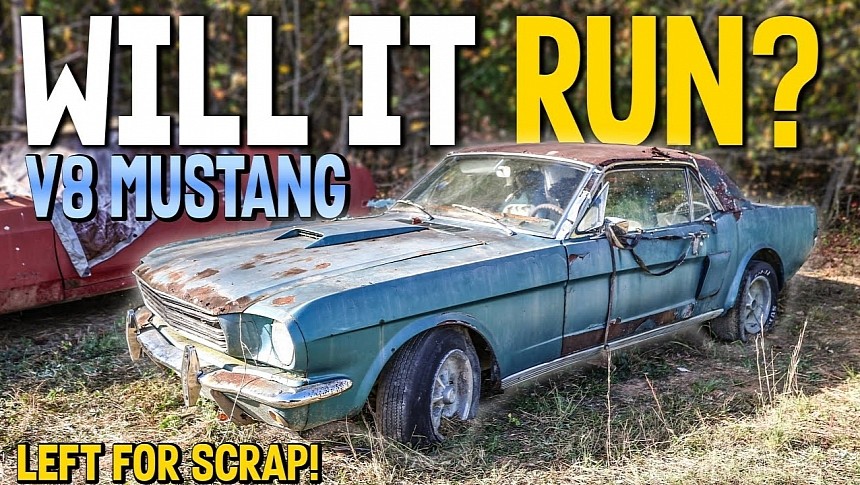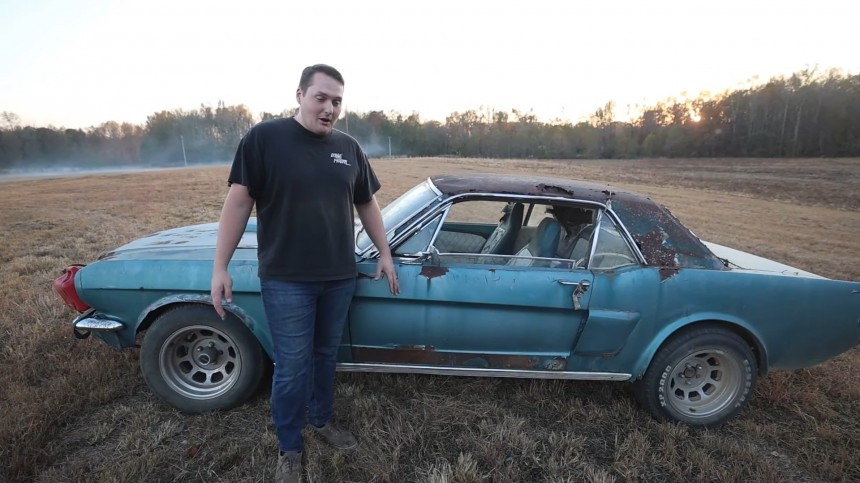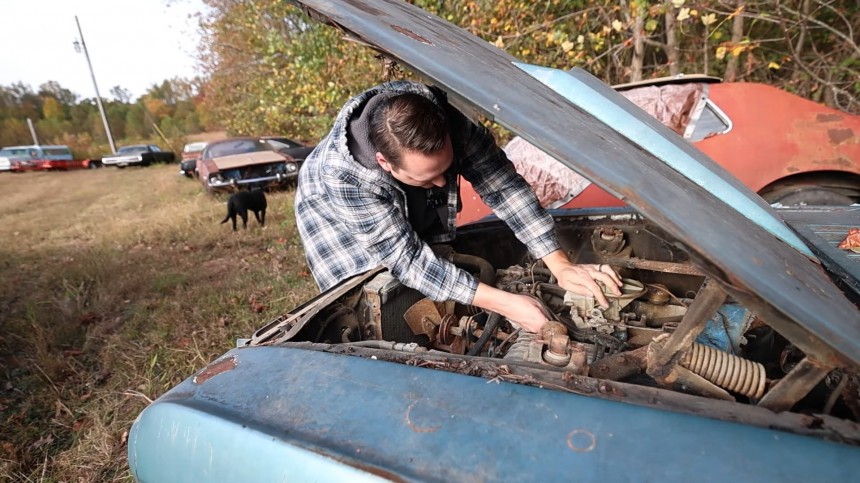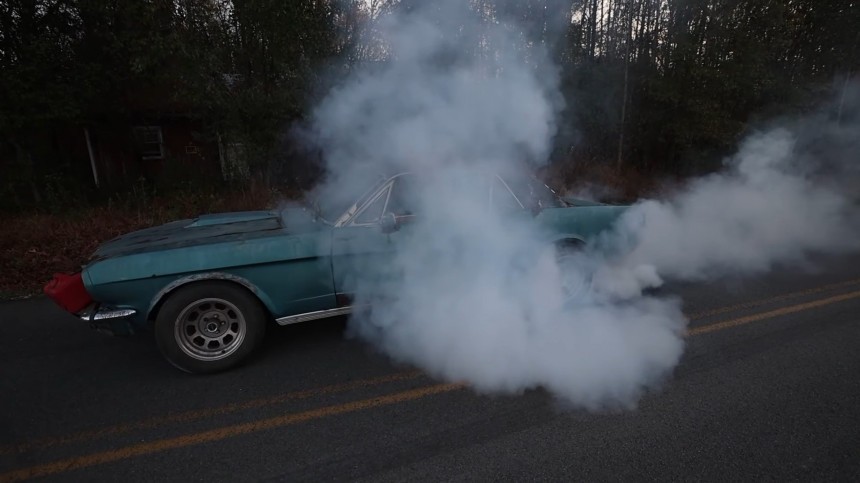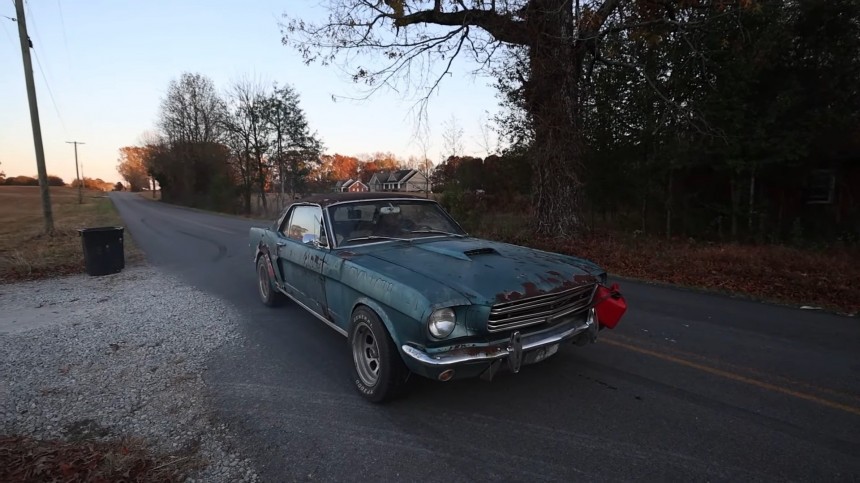Sometimes, car rescuers don’t know when to call it quits and simply abandon hopeless pieces of junk in the insatiable jaws of the crusher. It’s the same story with this derelict Mustang from the nameplate’s most productive model year, 1966. Rotten beyond all hope, the desecrated Ford still has enough life left in it to leave some tire marks in the dirt, courtesy of a stubborn YouTuber that isn't even a Ford guy.
When Henry Ford built his first Ford automobile, the Model T, in 1908, he gave America the kick-start it needed to adopt the car on a large scale. Within a decade, half of all motorcars in the nation came from Ford. The Model T was affordable, cheap to maintain, reliable, easy to operate, and brought enough benefits to the owner to be worth the expenses.
The recipe was not a Ford patent, but Henry Ford made it a staple of Blue Oval when another American motoring legend debuted – and took over the country once more. The year was 1964: Henry Ford was not the company’s founder, but his grandson – aptly distinguished by ‘the Second’ appellative – and he didn’t think twice when applying the Model T sales recipe to the Mustang.
It worked in a similar manner – the pony car became an instant success. Less than a year and a half after the April 14, 1964, initial sale, the Mustang production surpassed the one-millionth-unit mark. For clarification, the car debuted on April 17, 1964, at the New York World Fair, but the first example was actually sold by a Canadian dealer three days before the official premiere.
1966 remains engraved on the dado of the Mustang pedestal as the most prolific production run in the model's history, with 607,568 ponies galloping free and young. It is the only year the famous Ford (perhaps the best-known American automobile of all time) climbed over the 600,000-unit milestone.
Nowadays, a classic first-generation Ford Mustang is anything but rare – with notable exceptions, of course, like the Bosses of ’69 and ’70 or the Shelbys of the sixties. Still, there’s something hypnotic about an old Mustang, an unexplainable attraction that just doesn’t fade away with time. No matter how ordinary, everyday, mainstream, or average-Joe-looking and equipped a Mustang may be, it will always draw some attention to itself.
And when said Mustang is a junkyard find with one cylinder bank in the crusher, you can bet a full tank of gas that someone will at least notice. Sometimes, the spotter is also an avid gearhead addicted to anything old, moldy, crushable, and rusty, and a salvage operation is almost guaranteed.
Take this 1966 Ford Rustang as an example of the statement In the previous paragraph. That’s not a typo: not Mustang, but Rustang, since the car has more corrosion than actual metal. It’s more rust than a car, you might say, and you wouldn’t be wrong, and Dylan McCool agrees to this in full. He’s the YouTubing piston addict who decided to revive this terminal-stage rust Mustang and see if the flaky Ford will run and drive again.
Even more interesting is that he is a Mopar guy through and through, yet he didn’t pass the chance to turn a wrench on this too-far-gone pony car. The car is quite intriguing, to be honest, as it has more holes in the body than Bonnie and Clyde after their final encounter with the Texas Rangers, and yet some panels are in pretty good shape. The trunk lid and the front left fender strongly contrast the roof and its oxidation-derived direct and permanent ventilation above the right back seat.
However, the critical aspect of this Mustang is filled with great news – and riddles: the powertrain refused to die, and more importantly, it turns freely. The emblematic 289 CID V8 (4.7-liter) motor needs some help to get going once again; the two-barrel carburetor (not the original two-barrel Autolite, but a 2V Holley) is leaking – courtesy of crusty accelerator pump diaphragm.
The YouTuber decided to rebuild the carb just to stay close to the car's current form, but the Mustang had other wounds that needed attention. The three-speed automatic transmission is missing the gearshift lever, making the mission of moving the car around so much more exciting. Amazingly, after much wrenching, the zombie Rustang gets going under its own power – but only after it receives a new set of wheels to replace the one-piece magnesium Keystone Rogue ones.
Naturally, the new wheels don’t fit, and the YouTuber must cut the rear wheel arches to keep the rubber away from the fender. Perhaps the baseball bat/metal pipe trick could have done the job just fine and spared the car from shedding even more metal than it already has done. A solid round bar shoved between the tire and the fender will give a nice and even rounded edge.
The seized brakes probably sent this Mustang on permanent retirement in 2004, with no one to look after it. At some point in its life, the car underwent some cosmetic upgrades, with fake hood and side scoops, custom rocker arm covers, and interior.
This run-of-the-mill Mustang came with the 289 cubic-inch V8 when it was born. The famous Ford small-block also adorned the likes of Shelby Cobras (the early examples, after the 260 V8 was phased out) and the demigod Ford GT Mk I. Coincidentally, 1966 was the best Mustang sales year and the first Le Mans win for the Blue Oval (and perhaps the two occurrences are strongly related).
This particular example had the low-key 289 – pompously christened ‘Challenger V-8’ by Ford (hyphen included), with the two-barrel giving a modest 200 hp (203 PS) and 282 lb-ft (382 Nm) from the 9.3:1 compression ratio. The same engine, fed through a four-barrel carb and with the compression increased to 10:1, yielded an output of 225 hp and 305 lb-ft (228 PS, 414 Nm), called the Challenger Special.
Of course, the most famous 289 Ford V8 of them all would arguably be the high-revving HiPo Cobra version (High Power), rated at 271 horses and 312 lb-ft (275 PS / 423 Nm), thanks to its 10.5:1 compression ratio. And lastly, the 289 was the foundation on which Shelby American built the notorious GT350 Mustangs. With a 715 CFM 4-BBL Holley carburetor, the 289 would output 306 bhp (310 PS) at 6,000 RPM and 329 lb-ft (446 Nm) at 4,200 rpm. Period literature identified this engine as the "Cobra hi-riser" due to its high-riser intake manifold.
Although the Rustang found by Dylan McCool sits at the base of the power stats food chain, the 289 in it doesn’t give in as quickly as the body did. Amazingly, after two days of work, the plagued Mustang runs again – and it even attempts to do a donut, in lack of a better display of performance. Despite its disappointing apparel – to the point that viewers suggest it be scraped, save for the engine, tranny, and rear – the YouTuber is not yet convinced that a complete makeover would be an utter waste of money and time.
The recipe was not a Ford patent, but Henry Ford made it a staple of Blue Oval when another American motoring legend debuted – and took over the country once more. The year was 1964: Henry Ford was not the company’s founder, but his grandson – aptly distinguished by ‘the Second’ appellative – and he didn’t think twice when applying the Model T sales recipe to the Mustang.
It worked in a similar manner – the pony car became an instant success. Less than a year and a half after the April 14, 1964, initial sale, the Mustang production surpassed the one-millionth-unit mark. For clarification, the car debuted on April 17, 1964, at the New York World Fair, but the first example was actually sold by a Canadian dealer three days before the official premiere.
Nowadays, a classic first-generation Ford Mustang is anything but rare – with notable exceptions, of course, like the Bosses of ’69 and ’70 or the Shelbys of the sixties. Still, there’s something hypnotic about an old Mustang, an unexplainable attraction that just doesn’t fade away with time. No matter how ordinary, everyday, mainstream, or average-Joe-looking and equipped a Mustang may be, it will always draw some attention to itself.
And when said Mustang is a junkyard find with one cylinder bank in the crusher, you can bet a full tank of gas that someone will at least notice. Sometimes, the spotter is also an avid gearhead addicted to anything old, moldy, crushable, and rusty, and a salvage operation is almost guaranteed.
Even more interesting is that he is a Mopar guy through and through, yet he didn’t pass the chance to turn a wrench on this too-far-gone pony car. The car is quite intriguing, to be honest, as it has more holes in the body than Bonnie and Clyde after their final encounter with the Texas Rangers, and yet some panels are in pretty good shape. The trunk lid and the front left fender strongly contrast the roof and its oxidation-derived direct and permanent ventilation above the right back seat.
However, the critical aspect of this Mustang is filled with great news – and riddles: the powertrain refused to die, and more importantly, it turns freely. The emblematic 289 CID V8 (4.7-liter) motor needs some help to get going once again; the two-barrel carburetor (not the original two-barrel Autolite, but a 2V Holley) is leaking – courtesy of crusty accelerator pump diaphragm.
Naturally, the new wheels don’t fit, and the YouTuber must cut the rear wheel arches to keep the rubber away from the fender. Perhaps the baseball bat/metal pipe trick could have done the job just fine and spared the car from shedding even more metal than it already has done. A solid round bar shoved between the tire and the fender will give a nice and even rounded edge.
The seized brakes probably sent this Mustang on permanent retirement in 2004, with no one to look after it. At some point in its life, the car underwent some cosmetic upgrades, with fake hood and side scoops, custom rocker arm covers, and interior.
This particular example had the low-key 289 – pompously christened ‘Challenger V-8’ by Ford (hyphen included), with the two-barrel giving a modest 200 hp (203 PS) and 282 lb-ft (382 Nm) from the 9.3:1 compression ratio. The same engine, fed through a four-barrel carb and with the compression increased to 10:1, yielded an output of 225 hp and 305 lb-ft (228 PS, 414 Nm), called the Challenger Special.
Of course, the most famous 289 Ford V8 of them all would arguably be the high-revving HiPo Cobra version (High Power), rated at 271 horses and 312 lb-ft (275 PS / 423 Nm), thanks to its 10.5:1 compression ratio. And lastly, the 289 was the foundation on which Shelby American built the notorious GT350 Mustangs. With a 715 CFM 4-BBL Holley carburetor, the 289 would output 306 bhp (310 PS) at 6,000 RPM and 329 lb-ft (446 Nm) at 4,200 rpm. Period literature identified this engine as the "Cobra hi-riser" due to its high-riser intake manifold.
Although the Rustang found by Dylan McCool sits at the base of the power stats food chain, the 289 in it doesn’t give in as quickly as the body did. Amazingly, after two days of work, the plagued Mustang runs again – and it even attempts to do a donut, in lack of a better display of performance. Despite its disappointing apparel – to the point that viewers suggest it be scraped, save for the engine, tranny, and rear – the YouTuber is not yet convinced that a complete makeover would be an utter waste of money and time.
